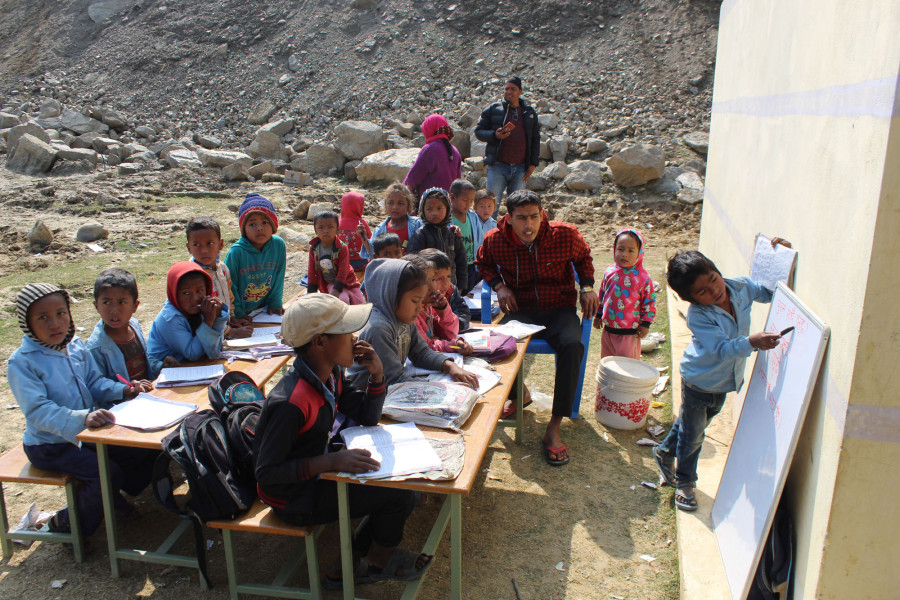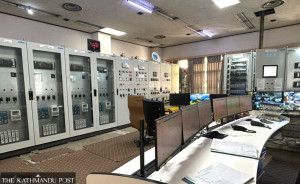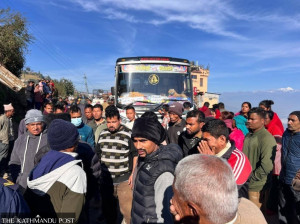Bagmati Province
A majority of community schools destroyed in the 2015 earthquake yet to be constructed
For lack of proper infrastructure, a school in Sindhuli, like many others, conducts classes under the open sky.
Raj Kumar Karki
The 2015 earthquake destroyed 64 community schools in Golanjor, Sindhuli. Of them, only 10 school buildings have been built so far. Sunkoshi Basic School, in Golanjor, is one of the schools that is still awaiting reconstruction of its infrastructure.
The school runs classes from grades one to five with a total of 57 students. And after the school’s building was destroyed by the earthquake, the District Project Implementation Unit (Education) of the National Reconstruction Authority built a two-room building for the school. Before the earthquake, the school was a five-room building.
Surendra Prasad Neupane, the school headmaster, said that the school’s earlier building was hardly enough to accommodate the number of students but the current one is just too small. “We only have two rooms so we run our classes outside in the open field. But during gloomy and rainy days, it’s difficult to even do that,” he said.
The school, which was established 23 years ago, has five staff in the school including teachers, a facilitator for the Child Development Centre and an office assistant. “When it rains we have no other option than to put all the students in a single room. On clear days, students are segregated into different groups and we run the classes outside,” said Neupane.
Gangadevi Dahal, the facilitator of the Child Development Centre, said students from Golanjor and Fikkal in Sindhuli, Masalighat of Ramechhap, and Nabalpur in Okhaldhunga attend the school underlining the important role the school plays in the area.
Ekraj Neupane, a local of Golanjor, said his one-year-old daughter Savyata studies in grade one. “We don’t send Savyata to school when it rains or when the weather is stormy,” said Neupane, “this affects her studies but we can’t send her to knowing that she’s unsafe there.” Neupane has been requesting concerned authorities to complete construction of the school building soon.
Dahal says that winters are rough for the children and the school staff, and that has gone on to affect the quality of education in the school. “It’s twice as hard during the monsoons to take classes. We are trying to arrange for basic facilities to students that it’s impossible to focus on the quality of classes we conduct,” she said.
Under the initiation of the District Project Implementation Unit, a four-room building for the school is currently under construction, but it is a long way from being complete, says Netra Prasad Gajurel, chief at the District Education Unit. He said, “The construction work of the school started a year ago. The building is being constructed at a total cost of Rs6.9 million. We plan to complete the construction of the building within six months.”
According to Gajurel, 100 (out of 280 quake-ravaged community schools) are yet to be rebuilt. “The construction work of around half of the quake-ravaged community schools is underway,” said Gajurel.
Government records show over 33,000 classrooms in 7,923 public schools in 32 districts across the country were destroyed in the 2015 earthquakes. Due to the lack of students, 370 such schools were merged and 7,553 school buildings had to be rebuilt. So far, 4,476 school buildings have been rebuilt, while 1,772 buildings are under construction.
The government is yet to plan the reconstruction of 910 school buildings, mainly for the lack of budget. According to the Post-Disaster Recovery Framework prepared by the National Reconstruction Authority in 2016, Rs 180 billion would be required for the construction of the quake-destroyed academic institutions and that Rs 167 billion would be needed to rebuild schools and classrooms. The budget was later revised to Rs 119 billion, out of which Rs 50 billion has been pledged by donors in the form of loans and grants.




 7.12°C Kathmandu
7.12°C Kathmandu













